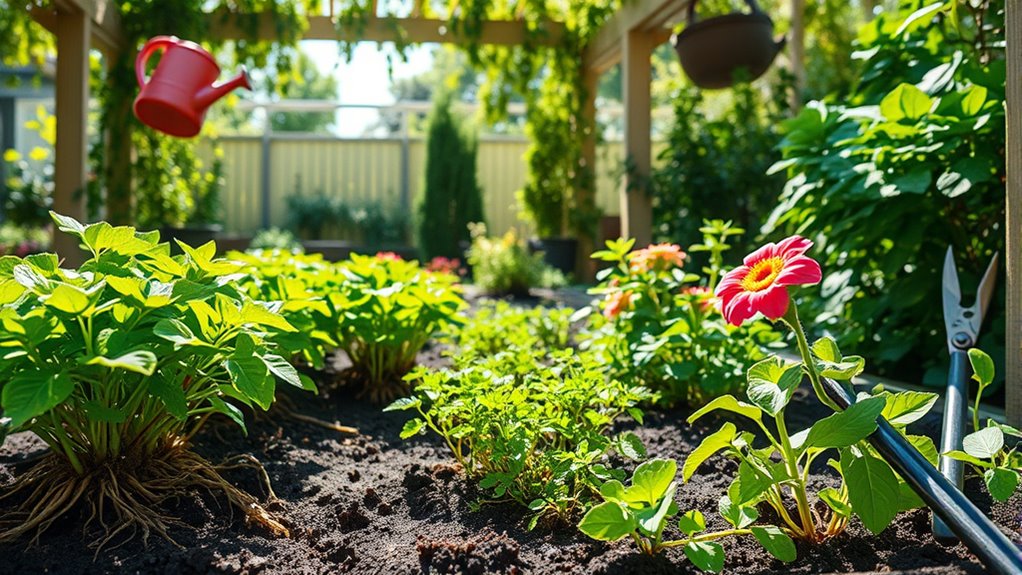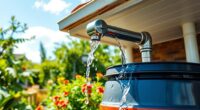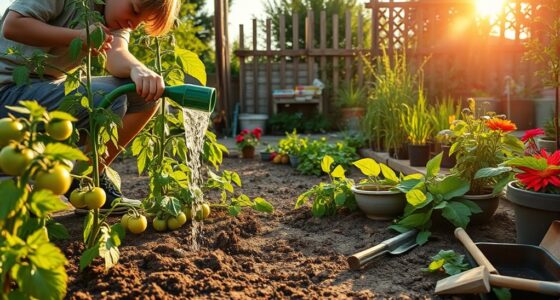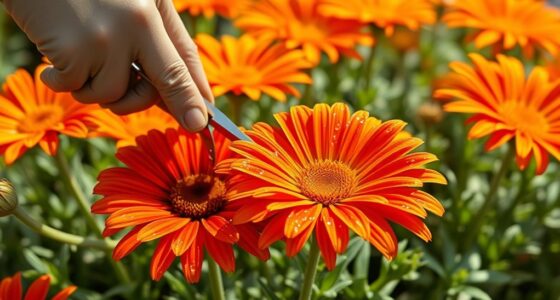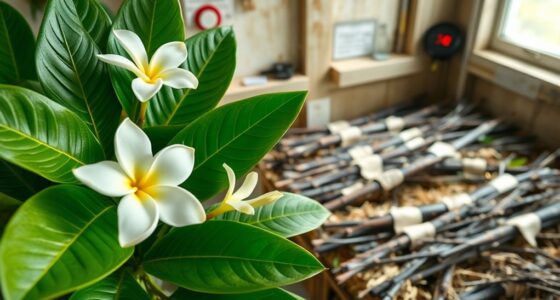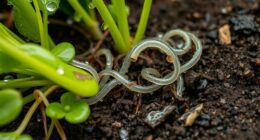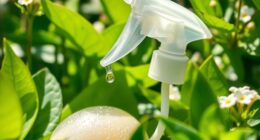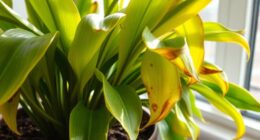To avoid common gardening mistakes, guarantee you prepare your soil properly by testing pH, adding organic matter, and loosening compacted soil. Don’t skip monitoring for pests early on; using natural controls and physical barriers helps protect your plants. Also, maintain consistent watering and fertilizing to keep plants healthy. Rushing or neglecting these basics can lead to poor growth, pests, and low yields. Keep these tips in mind to start strong and build a thriving garden.
Key Takeaways
- Skipping thorough soil preparation can hinder plant growth; always test and amend soil before planting.
- Neglecting pest prevention allows minor issues to become severe; implement early detection and natural control methods.
- Rushing planting or overwatering can damage roots and reduce yields; follow proper timing and watering practices.
- Ignoring plant-specific needs leads to poor growth; research each plant’s light, water, and nutrient requirements.
- Failing to maintain consistent care and monitoring increases the risk of pests and disease; establish regular garden checks.
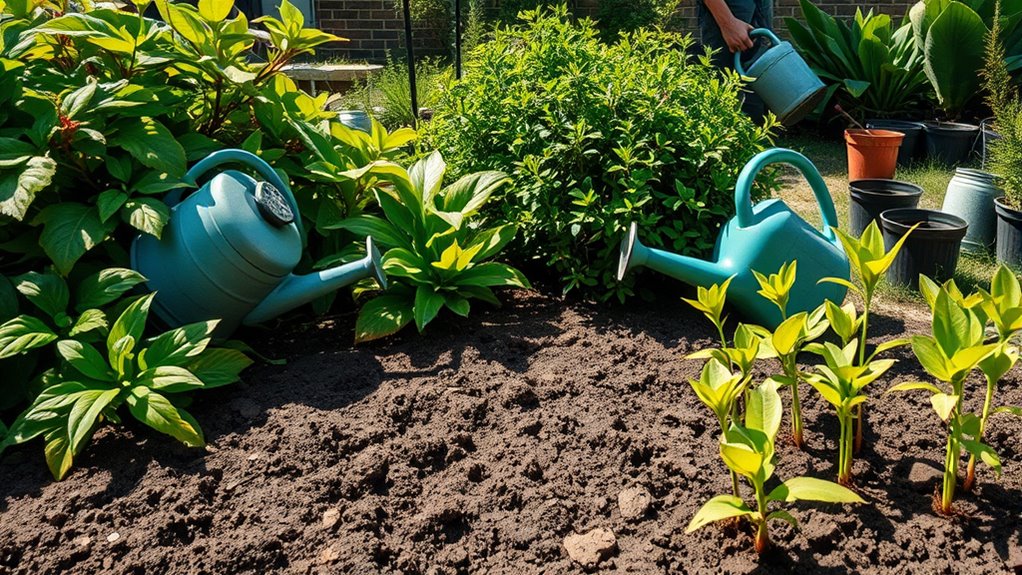
Starting a garden can be exciting, but beginners often make common mistakes that hinder their success. One of the most essential steps is soil preparation. Skipping or rushing this process can lead to poor plant growth and reduced yields. Before planting, you should test your soil to understand its pH and nutrient levels. This simple step helps you know what amendments are necessary to create a fertile environment. Adding compost or organic matter improves soil structure, drainage, and nutrient content. Without proper soil preparation, your plants may struggle to establish roots, become stunted, or succumb to diseases. Take the time to loosen compacted soil and remove weeds, which compete for nutrients and water. Doing so promotes healthy root development and guarantees your plants have the best start. Additionally, understanding soil health can help you adopt practices that sustain your garden’s productivity over time.
Another critical aspect often overlooked by beginners is pest control. Many new gardeners underestimate the importance of managing pests early on, which can quickly turn a thriving garden into a battleground. Instead of reacting after pests have infested your plants, develop a proactive pest control plan. Use physical barriers like row covers to keep pests away and regularly inspect your plants for signs of infestation. Identifying pests early allows you to target them precisely, reducing the need for chemical interventions. Natural methods, such as introducing beneficial insects like ladybugs or applying neem oil, can help control pests without harming your plants or the environment. Remember, healthy plants are more resistant to pests, so maintaining proper watering, fertilizing, and soil health is equally essential.
Frequently Asked Questions
How Do I Choose the Right Plants for My Climate?
To choose the right plants for your climate, you need to understand plant compatibility and your climate zone. Start by identifying your USDA hardiness zone, which guides you in selecting plants suited to your weather conditions. Look for plants labeled for your zone, ensuring they can thrive in your environment. This way, you’ll enjoy healthier, more successful gardening without wasting time or resources on unsuitable plants.
When Is the Best Time to Water New Plants?
Think of watering your new plants like tending a delicate flame—you don’t want to douse it or let it flicker out. The best time to water is early morning or late afternoon, giving your plants a steady watering schedule that encourages healthy growth. As your plants reach maturity, adjust your watering routine accordingly, ensuring they get enough moisture without overdoing it, which helps prevent root rot and promotes strong roots.
How Can I Prevent Pests Without Chemicals?
To prevent pests without chemicals, you can use natural pest control methods like introducing beneficial insects such as ladybugs and lacewings. Additionally, practice companion planting by growing pest-repellent plants like marigolds and basil alongside your vegetables. These strategies create a healthy garden ecosystem, making pests less likely to invade. Regularly inspect your plants and remove any pests by hand to keep your garden thriving without harmful chemicals.
What Soil Type Is Best for Beginners?
For beginners, loamy soil is the best choice because it balances sand, silt, and clay, providing good drainage and nutrients. You should start with soil amendments like compost to improve fertility and pH testing to guarantee the soil isn’t too acidic or alkaline. Regularly adjusting the pH helps plants thrive. With this foundation, your garden will grow healthy and strong, setting you up for success.
How Often Should I Fertilize My Garden?
You should fertilize your garden based on a consistent fertilizer schedule that fits your plants’ needs. Typically, applying fertilizer every 4-6 weeks during the growing season works well. Focus on nutrient management by using the right type of fertilizer and avoiding overfeeding, which can harm plants. Regular feeding guarantees your garden gets essential nutrients, promotes healthy growth, and prevents deficiencies. Adjust your schedule as plants mature or if you notice signs of imbalance.
Conclusion
By avoiding these common mistakes, you’ll set yourself up for a successful gardening journey. Remember, patience and observation are key—don’t rush the process or get discouraged by setbacks. With a little effort and attention, you’ll see your garden thrive. So, are you ready to learn from these tips and grow a beautiful, healthy garden? Start today, keep learning, and enjoy the rewarding experience of nurturing your own green space. Happy gardening!
